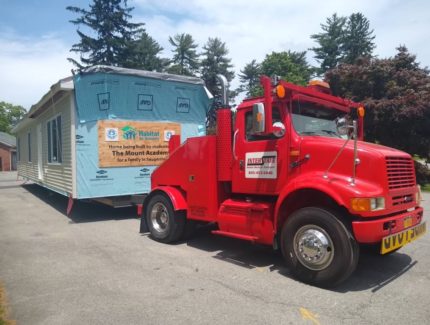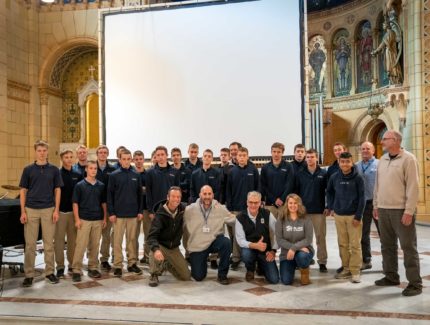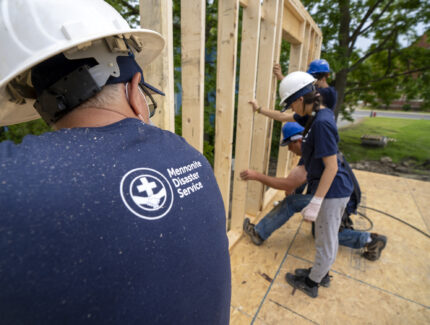
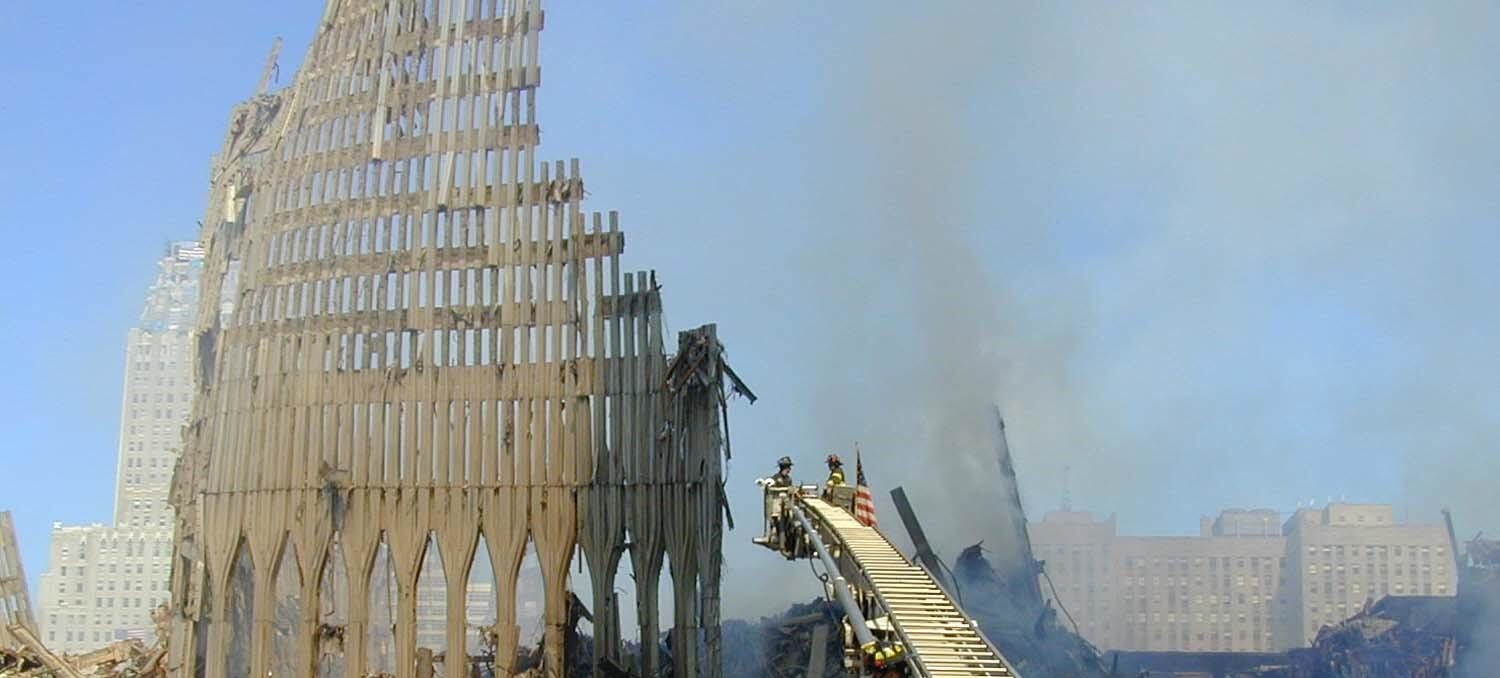
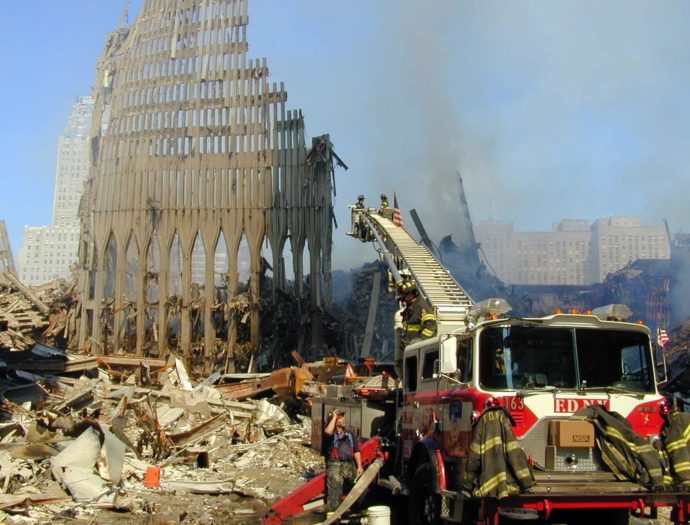
October 28, 2021
20 years since 9/11
MDS looks back
The year 2021 marks 20 years since terrorists took 2,996 lives in attacks on the United States on Sept. 11, 2001. The following brings back some memories of the ways in which Mennonite Disaster Service (MDS) responded.
“How to get people in churches free from disabling fear, pain and uncertainty.”
That’s how Joe Steiner descries the essence of the MDS response in the wake of the Sept. 11 terrorist attacks.
What eventually became a project called “Restoring Hope” began when MDS leaders at the time were trying to creatively, as Steiner put it, “get people in churches out of their disease” and focus on turning hope into action.
It was a time in the U.S. when many people were stuck in state of confusion, uncertainty, or fear—and some in full-blown emotional turmoil. In fact, the entire country seemed collectively full of fear, and many people expected additional attacks.
Just after the attacks, MDS spent many days in a state of uncertainty, too.
When American Airlines Flight 11 was flown into the North Tower of the World Trade Center, Steiner—a social work professor also trained in critical incident stress—was in Akron, Pennsylvania, leading a workshop for MDS on how to deal with stress.
“Ted Houser—who was MDS communications manager at the time—interrupted us to tell us a plane had hit the World Trade Center,” he said. “We didn’t know whether it was an accident.”
Once the news broke that it was indeed a terrorist attack, and that other attacks had happened, Tom Smucker—at that time MDS executive director—adjourned the workshop.
“People wanted to call their families,” said Steiner. He returned to his home in Syracuse, New York, not knowing what MDS would do.
Not long after that, Smucker’s phone started ringing.
“We had constituents wanting us to do something,” said Smucker, remembering that time being like steering a ship that, initially, wasn’t quite sure of its destination.
“Many MDS leaders were asking, ‘What is MDS supposed to do after an attack, or in an urban setting like New York City, or where we can’t swing a hammer?’ ” he recalls.
Even though MDS wasn’t sure what it could do, people kept calling and donating.
“They were wanting MDS to do something,” said Smucker, noting MDS at that time was focused on a vision of repairing or rebuilding after natural disasters.
“Constituents were sending in money with the expectation that MDS would do something related to 9/11. But what in the world were we supposed to do?”
Smucker—who was and still is known in the disaster response arena for thinking creatively and building teams that get stuff done—spent hours on the phone and in meetings with other faith-based disaster response groups, with the Federal Emergency Management Agency, and with MDS leaders including Steiner and Paul Unruh.
Unruh recalled when donations began pouring in. “We got more donations for 9/11 than any prior disaster we had up to that date,” he said.
Restoring Hope
Together, Smucker, Steiner, and Unruh—and they would add many others, including longtime MDSer Bernard Martin—helped shape “Restoring Hope,” which remains a unique effort in MDS’s history where the organization temporarily put down its collective hammer, at least initially, and picked up the tools of listening and accompaniment.
They began by setting up “listening circles,” at Anabaptist-Mennonite churches in New York City and Washington, based loosely on a concept Steiner previously used to help police, firefighters, and other first responders cope with post-traumatic stress disorder.
The first church Steiner worked with was First Mennonite Church in Manhattan, the closest Mennonite church to the scene of the attack. The pastor, facing health challenges, needed help ministering to her members in need.
Ultimately, MDS worked with 22 Anabaptist churches in New York City and another 21 Anabaptist churches in Washington, D.C. Since a high percentage of the churches had non-English-speaking members, this meant working through interpreters in many cases. Through Restoring Hope, MDS worked with all kinds of congregations, helping individuals and churches not only get “un-stuck,” but reach new levels of resiliency and action they never before saw in themselves.
“For every person who shut down, there was another group of people who become heroes and went way beyond what they’d ever done before,” said Steiner. “Restoring Hope was a project to move from emotional uncertainty and fear to action, to a better future than what they had before.”
For MDS, Restoring Hope also meant relying on local leadership from representatives of churches in New York and Washington, D.C. “A local committee gave leadership, with a representative from MDS, to working with individual congregations to initiate, develop and fund Restoring Hope projects,” said Steiner. “Projects had to be directly related to 9/11.”
“He told me to do whatever I could so that the ministers we were helping would still be there one year after, two years after 9/11. As far as I know, no minsters left during that time. This was not the case in Oklahoma City after the Murrah Building was bombed—when a high percentage left the ministry within three years."
— Joe Steiner, MDS Leadership Volunteer
A chance to be heard
The conversations within listening circles were very significant, said Unruh, since they afforded each member of a congregation a chance to be heard by the others.
“The congregations heard many individuals’ stories that had not yet been shared and perhaps would not have been shared without these debriefing sessions,” he said. “Many also provided an opportunity for some of the pastors to hear how 9/11 events had affected their members.”
Churches began not only processing their grief, anger and fear, but deciding on how to emerge and move forward.
“Some decided to go out and interview people in their neighborhood to find out what they needed, and how 9/11 impacted them,” Steiner said. “They could provide childcare, they could provide meals, and some even developed listening circles for neighbors.”
Another church provided sewing machines and taught people the skills they’d need to get higher-paying jobs. Others taught people how to use computers. Still others provided a comfortable communal space for the families of firefighters and police officers who were working 12-hour shifts for months following the attacks.
“One minister wanted some renovation done in his basement so that young people could come into the city and hand out tracts,” recalled Steiner.
“Another wanted space to put in a food pantry. Another church developed and decorated a peace center in the basement of their church where Christians, Jews and Muslims could meet. This church also sponsored a peace festival out on the street. The city closed the street and neighbors brought ethnic foods to the street, and music from different ethnic groups was provided.”
The youth in New York also developed a 9/11 musical, which was performed in some New York City churches as well as some Mennonite churches and schools beyond New York.
From inaction to active hope
Sometimes something as simple as having eye contact with neighbors of the church became the evidence that people were moving toward hope and resilience.
Steiner recalled one congregation describing how they once walked to church with their heads down. “But after participating in a listening group, they walked with their heads up and had eye contact,” he said. “It was one of many illustrations on how to move from pain and stuck-ness to resiliency.”
At first, it was difficult to get congregations to voice what they needed, Unruh reflected. “Congregation after congregation told us that they hadn’t been harmed,” he said. “Then, for hours afterward, they told us ways in which they had been harmed. They simply had not labeled themselves as victims.”
Unruh and Steiner also ran retreats for pastors.
“The agenda was to give them a chance to process what they had experienced and to also learn to do ‘trauma reduction’ in their congregations,” Unruh said. “If my memory serves me right, 100 percent of the pastors participated.”
Steiner remembers Tom Smucker clearly stating a goal as they put Restoring Hope into action.
“He told me to do whatever I could so that the ministers we were helping would still be there one year after, two years after 9/11,” said Steiner. “As far as I know, no minsters left during that time. This was not the case in Oklahoma City after the Murrah Building was bombed—when a high percentage left the ministry within three years.”
MDS did not work alone
It’s important to note that MDS didn’t work alone but with many faith-based groups and the federal government.
The STAR—or Strategies for Trauma Awareness and Resilience—program began in the wake of the events of 9/11 as a partnership between Church World Service and Eastern Mennonite University to equip community leaders to understand the dynamics of trauma and healing, and their linkage to issues of conflict, justice and peace.
“MDS donors, along with other disaster response faith-based organizations, funded the beginning of this powerful and effective program,” said Unruh, who served on a focus group that assisted in the program’s development.
“I believe the STAR program is one of the best examples of turning a great tragedy into something positive,” he said.
“The trauma that many experienced around the 9/11 events was turned into one of the most effective trauma reduction programs in the world. MDS, along with several other agencies, played a huge role in helping it to happen—thanks again to our wise and compassionate donors!”

